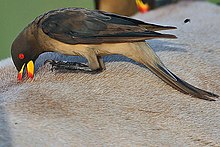Yellow-billed oxpecker
| Yellow-billed oxpecker | |
|---|---|

| |
| An adult bird in typical feeding mode | |
| Scientific classification | |
| Kingdom: | |
| Phylum: | |
| Class: | |
| Order: | |
| Family: | |
| Genus: | |
| Species: | B. africanus
|
| Binomial name | |
| Buphagus africanus Linnaeus, 1766
| |

| |
| Range of the yellow-billed oxpecker | |
The yellow-billed oxpecker (Buphagus africanus) is a passerine bird in the starling and myna family, Sturnidae; some ornithologists regard the oxpeckers to be a separate family, the Buphagidae (Zuccon, 2006). It is native to the savannah of sub-Saharan Africa from Senegal east to Sudan. It is least common in the extreme east of its range where it overlaps with the red-billed oxpecker, despite always dominating that species when feeding.
Behavior
The yellow-billed oxpecker nests in tree holes lined with hair plucked from livestock. It lays 2–3 eggs. Outside the breeding season it is fairly gregarious, forming large, chattering flocks. Non-breeding birds will roost on their host animals at night.
The yellow-billed oxpecker eats insects and ticks. Both the English and scientific names arise from this species' habit of perching on large wild and domesticated mammals such as cattle and eating arthropod parasites. It will also perch on antelopes such as wildebeest. In a day an adult will take more than 100 engorged female Boophilus decoloratus ticks or 13,000 larvae.
However, their preferred food is blood, and while they may take ticks bloated with blood, they also feed on it directly,[2] pecking at the mammal's wounds. So the good the bird does to the mammal may be negated by its keeping the wounds open to parasites and disease [citation needed]. Whatever the net result, mammals generally tolerate oxpeckers.[2]
The yellow-billed oxpecker is 20 cm long and has plain brown upperparts and head, buff underparts and a pale rump. The feet are strong. The adults' bills are yellow at the base and red at the tip, while juveniles have brown bills.[3] Its flight is strong and direct. The call is a hissy, crackling krisss, krisss.
References
- ^ Template:IUCN
- ^ a b Feare, Chris J. (2003). "Starlings and Mynas". In Christopher Perrins (ed.). Firefly Encyclopedia of Birds. Firefly Books. pp. 530–533. ISBN 1-55297-777-3.
- ^ Mclachlan, G. R.; Liversidge, R. (1978). "747 Yellow-billed Oxbecker". Roberts Birds of South Africa. Illustrated by Lighton, N. C. K.; Newman, K.; Adams, J.; Gronvöld, H (4th ed.). The Trustees of the John Voelcker Bird Book Fund. p. 534.
- Birds of The Gambia by Barlow, Wacher and Disley, ISBN 1-873403-32-1
- Starlings and Mynas by Feare and Craig, ISBN 0-7136-3961-X
- Zuccon, Dario; Cibois, Anne; Pasquet, Eric & Ericson, Per G.P. (2006): Nuclear and mitochondrial sequence data reveal the major lineages of starlings, mynas and related taxa. Molecular Phylogenetics and Evolution 41(2): 333-344. doi:10.1016/j.ympev.2006.05.007 PMID 16806992 (HTML abstract)
External links
- Yellow-billed oxpecker - Species text in The Atlas of Southern African Birds.

